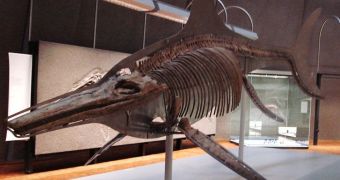A team of investigators is proposing that an enormous, Kraken-like marine invertebrate may have roamed our planet's oceans between 250 and 200 million years ago. While no direct evidence of the creatures exists, they may have left behind gruesome, tell-tale signs of their presence.
Investigators made the recent proposal after analyzing a treasure trove of ichthyosaur fossils dating back to the upper Triassic period. These animals were the equivalent of modern-day sperm whales, and were until recently thought to have been at the top of the food chain while they lived.
But Mount Holyoke College paleontologist Mark McMenamin says that his investigations of the fossils uncovered at the Berlin-Ichthyosaur State Park, in Nevada, reveal a different conclusions. He proposes the existence of an even larger monster, capable of killing off ichthyosaurs easily.
On average, an ichthyosaur could grow between 2 to 4 meters (6.6 to 13 feet) in length, and weight between 1.03 and 1.05 tons. However, some exemplars are known to have exceeded these measurements by a wide margin.
According to McMenamin, the Nevada site reveals a concentration of ichthyosaur fossils that is staggering simply for the fact that it's ordered. That is to say, the bones are disposed in a nearly geometrical pattern throughout the deposit.
At first, experts proposed that this arrangement was obtained as the animals died in shallow water. But the latest geological evidence seems to indicate that water at the location was a lot deeper than originally calculated. The new study proposes that the location was in fact a predator den.
Details of the proposal were presented on Monday, October 10, at the annual meeting of the Geological Society of America, which was held in Minneapolis, Minnesota. The investigation was carried out on 45-foot (14-meter) ichthyosaurs of the species Shonisaurus popularis, Science Blog reports.
“It became very clear that something very odd was going on there. It was a very odd configuration of bones,” the team leader explains. He explains that the bone arrangements are most likely to result of intelligent actions by a yet-unknown predator.
“Modern octopus will do this. I think that these things were captured by the kraken and taken to the midden and the cephalopod would take them apart,” the investigator believes. But the string of coincidence just keeps getting weirder.
By looking at the bone arrangement, researchers saw a broader pattern, showing that the ichthyosaur vertebrae were arranged in the pattern of coleoid sucker disks on a regular tentacle. Could this be evidence of a self-portrait that was literally being created before history itself?
“We think that this cephalopod in the Triassic was [killing the ichthyosaurs]. It was either drowning them or breaking their necks,” McMenamin concludes.

 14 DAY TRIAL //
14 DAY TRIAL //